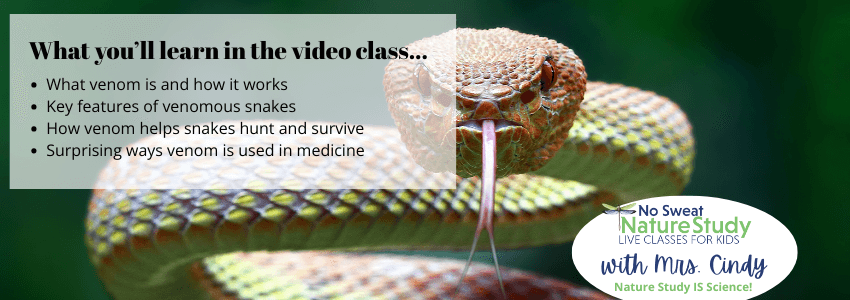Why Do Some Animals Slither? Science Lesson for Kids
Have you ever watched a snake glide across the ground and wondered how it moves without any legs? In this episode of the No Sweat Nature Study Podcast, Mrs. Cindy explains the fascinating science behind slithering. You’ll find out how muscles, body shape, and special belly scales work together to help snakes and other surprising animals move with ease.
Slithering isn’t just a spooky Halloween curiosity. It’s a smart survival adaptation! From sidewinding snakes to wiggly worms, you’ll learn how animals use this unique motion to hunt, hide, and thrive. Be sure to listen for the Science Snicker and test your knowledge with a fun 3, 2, 1 question at the end.
Venomous Snake Nature Study
Use these questions to check your child’s understanding after listening to the episode. You can ask them aloud or print the list for a quick review of science.
- What is slithering? (It’s a way animals move without legs by using muscles, body shape, and friction.)
- Which animal is best known for slithering? (Snakes!)
- What special part of a snake’s body helps it grip the ground? (Belly scales.)
- Name one style of snake slithering mentioned in the episode. (Serpentine, concertina, or sidewinding.)
- Why is slithering helpful to snakes when they hunt? (Because it lets them move quietly and sneak up on prey.)
- What’s one other animal besides a snake that slithers? (Worms, legless lizards, or caterpillars – sort of.)
- What tiny structures help worms move through soil? (Setae, or tiny bristles.)
- What part of a snake’s body has powerful muscles to help with movement? (Its long body from head to tail.)
Venomous Snake Nature Study Video Class
The upcoming Venomous Snakes – Danger, Design, and Discovery video class is packed with jaw-dropping science that brings slithering creatures to life in a whole new way. From learning how venom is made to discovering how it’s delivered through specialized fangs, students will gain a fascinating understanding of what makes venomous snakes both powerful and purposeful in nature.
Through an engaging nature journaling activity, students will draw and label the parts of a venomous snake while noting important details about its prey, habitat, and survival strategies. The class is perfect for 1st–8th graders and is available as part of the No Sweat Nature Study membership, which includes more than 175 science-rich video lessons just waiting to be enjoyed.

Booklist of Living Books for Nature Study
The No Sweat Nature Study Podcast community has been sharing recommendations of excellent nature-themed books. Click here to find a compilation of listener favorites!
Would you like to record a voicemail to answer this season’s nature study question?
At the end of each No Sweat Nature Study Podcast episode, Mrs. Cindy includes messages from a few of her friends. You can record a message that she might use on an upcoming episode!
All children must have their parents’ permission before leaving a recording. Parents are welcome to record an answer, too!
Each season, there will be a different question to answer. You can see this season’s question below. Think about your answer first, and then follow these simple directions:
- Click the “Start recording” button.
- Tell me your first name. (If you want to tell your age and/or where you live, feel free to do that.)
- You will have 60 seconds to answer the question, but try to be concise.
- Push the play button to listen to your recording before sending it, to ensure it is recorded correctly. If not, record it again.
Please leave a rating or a review on your podcast app! It helps the podcast to show up for more people…which means more families can enjoy science through the wonderful lens of nature study! Thank you!
